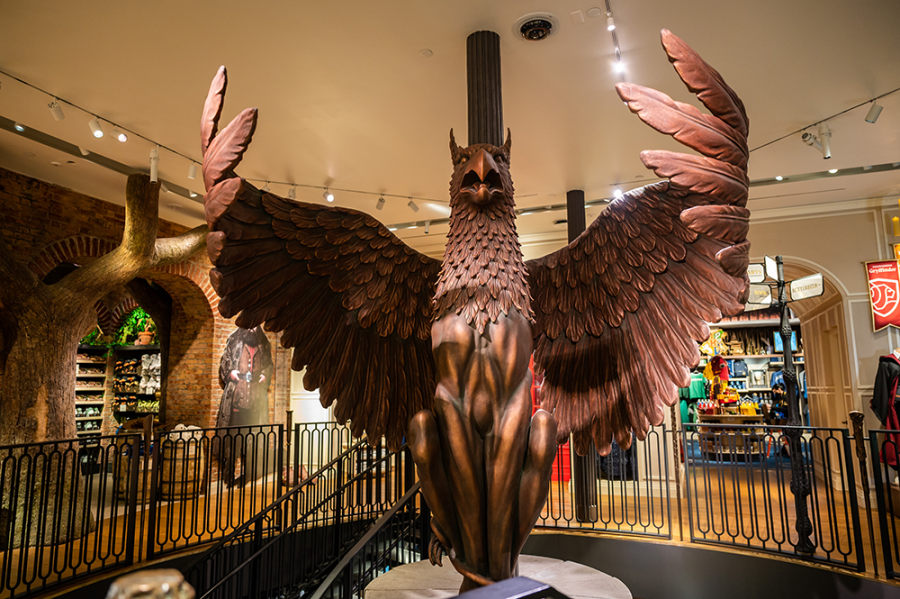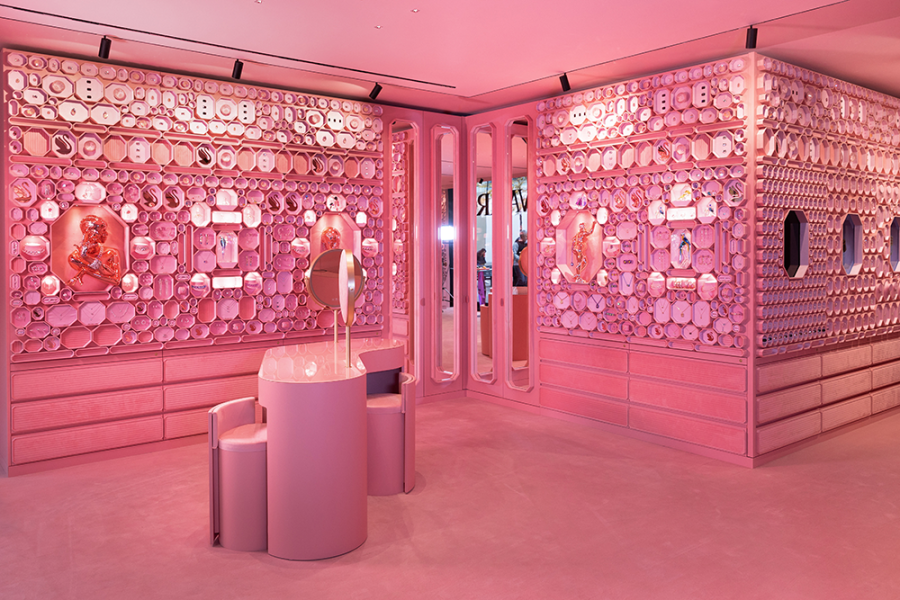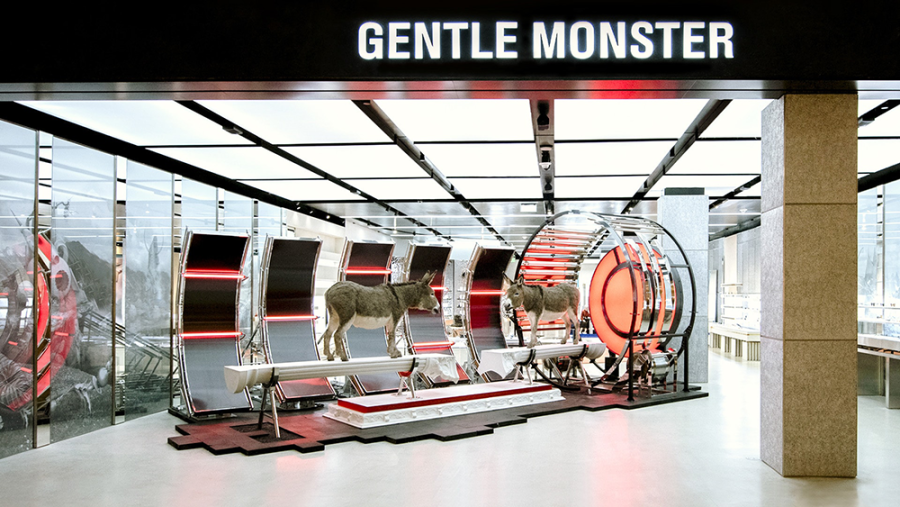That’s Retailtainment
Retailers once looked to the attractions industry for inspiration. But now, what can attractions learn from the latest brand experiences and how retailers are engaging with customers?

Harry Potter Magic
The Harry Potter New York store took its lead from the fans. “They were telling us for some time that they wanted to experience Harry Potter outside our U.K. home at Warner Bros. Studio Tour London – The Making of Harry Potter. New York was calling out as a location where we had a strong fan base,” says Karl Durrant, vice president and general manager at Warner Bros. Retail.
These are tough times for physical retailers, so the team needed to conjure something special. Harry Potter New York has its home in a handsome 19th-century building in Manhattan’s Flatiron District, where Hungarian Horntail dragons perch on historic clocks above the doorways. The team has obsessed over every detail of the store to delight fans. It is filled to the brim with must-sees, from Fawkes the phoenix hovering above shoppers’ heads to Dumbledore’s griffin guarding the stairway.
The staircase had to be an experience in itself, explains Durrant. The 21,000-square-foot store spans three floors, and the team wanted people to visit all levels. “It’s quite a breathtaking moment when you see the griffin spinning,” he says. “We’ve had fans crying.”
The store has exclusive products and experiences. Visitors receive a map to help them navigate around the 15 themed areas. “We also encourage them to download the Wizarding World app,” Durrant says.
The app gamifies the experience and improves visitor flow. App users will find 11 Enchanted Keys around the store, which unlock behind-the-scenes facts, figures, and videos. The Enchanted Keys are linked to authentic movie props, including Harry, Hermione, and Ron’s wands and a Golden Snitch. Guests who collect all 11 keys will receive a secret password to exchange for a prize.
Immersive digital attractions are integrated throughout, including two multiplayer virtual reality (VR) experiences: “Wizards Take Flight” and “Chaos at Hogwarts”—which can be prebooked for an extra fee.
Guests can handle wands belonging to nine characters at a round table inspired by Dumbledore’s Pensieve. Touching different wands triggers different content on the table’s domed screen.
“We have the world’s first Butterbeer Bar,” adds Durrant. MinaLima, the duo responsible for graphic design on the Harry Potter and Fantastic Beasts films, has also brought a House of MinaLima gallery and shop to the store.
Personalization is hugely popular in the Things That Must Be Named area. “You can personalize your wand, your journal, your robe, and your Hogwarts acceptance letter, which is really special,” Durrant says.
“You will also be served by people who love the brand as much as you do,” he continues. “We make sure that the people we employ are not only great retailers, but also fans.” Their enthusiasm keeps service levels high.
Durrant wants Harry Potter New York to have something for everyone. The store aims to satisfy the curious who may be delighted by the digital attractions, the fans who want to see favorite characters and props, and the superfans who can spot Easter eggs—such as the Ford Anglia headlights and the Dirigible Plum tree.
Warner Bros. collaborated on the store with the Household design agency. Cod Steaks created all themed elements, including the giant Fawkes. Technically Creative worked on the audiovisual, and The Workhaus handled fit-out.
Harry Potter New York attracted massive interest when it opened in June 2021. “With a virtual queuing system, we were able to control the numbers in-store and manage people’s expectations,” says Durrant, which was helpful when the store was operating at a reduced capacity throughout the pandemic. People were free to explore the Flatiron District and return when they received a text.
Warner Bros. is now working on the Warner Bros. Studio Tour Tokyo, opening in 2023.
According to Joe Pine—management advisor and author of books, including “The Experience Economy”—the Harry Potter New York store “is telling, not only for being IP-based and incredibly engaging and immersive, but because it has an experience for which it charges admission.” He sees it as a positive trend that “brands understand they are creating experiences, which means they should be charging admission—not necessarily for the entire location, but for places or activities inside.”
Pine says destinations like Guinness Storehouse in Dublin, Heineken Experience in Amsterdam, Land Rover Experience Centers, and Lego venues “are not just tremendous demand-generators for the core brand offerings, but ones that make a profit in and of themselves because they are admission-worthy.”
Meanwhile, attractions must “stop treating retail as an afterthought” and, instead, as “a co-equal source of engagement and revenue,” Pine believes.

(Photo Credit: BRC Imagination Arts)
Tasting Success
Success depends on “finding the right emotional stories that connect the heart of the audience with the heart of the brand,” says Christian Lachel, chief creative officer at BRC Imagination Arts. He shares author and marketing guru Seth Godin’s view that “people do not buy goods and services; they buy relations, stories, and magic.”
BRC Imagination Arts collaborated with the Diageo-owned Scotch whisky brand Johnnie Walker to create Edinburgh’s new Johnnie Walker Princes Street experience. It welcomes people wherever they are in their whisky journey and helps them get into the spirit.
Lachel believes brand homes have an advantage over traditional marketing because audiences already want to know their story. “People have invested their time, so you have to reward them with a great experience,” he says.
“Stories are stickier when you engage every single sense,” Lachel adds. Flavor is one way into the 200-year-old Johnnie Walker story. “Flavor is universal, and it’s something the audience understands,” he says. Everyone can discuss whether flavors are fruity, creamy, spicy, or smoky, even non-whisky drinkers.
The centerpiece of Johnnie Walker Princes Street is an immersive, multisensory 90-minute “Journey of Flavour” tour, led by a guide. After taking a quiz, which uses artificial intelligence to analyze people’s flavor preferences, guests are given wristbands color-coded to their personal flavor profile. They can then toast “Slàinte Mhaith” (“good health”) with three whisky drinks tailored to their tastes. “We’ve developed custom systems to deliver the whisky,” Lachel explains. The dispensing system saves over 50,000 glass bottles a year.
BRC Imagination Arts has delved into the brand’s archives to uncover its stories, presenting them in imaginative spaces across eight floors. The Come Walk With Us room tells the story of Johnnie Walker’s journey from farmer’s son to grocer to gifted whisky blender. It combines storytelling, choreography, travelators, and moving screens with a theatrical flourish, reflecting Edinburgh’s status as a festival city.
Choreography plays a big part in the experience. Take the Landscape of Flavour room, where guests discover how whisky is made. “First, we talk about people and place,” Lachel says. Exhibits and projections show Scotland’s “Four Corner” distilleries, crucial to making Johnnie Walker. Ingredients, such as apple slices and spices, are suspended in glass cloches. Then, guides produce flavored smoke bubbles for the audience. Visitors pop them to release flavors and aromas. “It’s about choreographing the sequence of the immersive elements to create the right emotional moment,” Lachel says.
Johnnie Walker Princes Street is home to two rooftop bars with panoramic views of Edinburgh and a shop where people can bottle their own whisky. There are two whisky tasting experiences available for an additional charge. The Explorers’ Bothy bar hosts single malt tastings, while whisky aficionados can sample rare whiskies from the cask in the Whisky Makers’ Cellar. There’s an events space, Label Studio, which can be used by the local community, and a Learning for Life Academy. The team worked with disabled access charity Euan’s Guide to make the venue inclusive and accessible for all. Visitor feedback has been “phenomenal,” says Lachel, and the brand’s conversion rate has skyrocketed.
To create transformative brand experiences, “engagement is the key word,” says author and management advisor Pine. Visitors should feel like “protagonists in the brand’s unfolding story” to develop emotional bonds, lasting memories, and lifetime loyalty.

Sense of Style
Swarovski’s new flagship store in Zurich, Switzerland, resembles an oversized jeweled box, dazzling visitors with sparkle and color. “We wanted to build a sense of wonder, tactility, and exploration,” says Giovanna Engelbert, Swarovski’s creative director.
The three-story store’s plush ground floor is awash in bold pinks, with crystal experts offering styling advice. The lower level is like a subterranean green crystal cave. Visitors can see a raw crystal exhibit showing a rainbow of crystals. A special table with integrated lenses allows people to take a closer look at crystals and products. Upstairs, a golden-hued floor previews future global locations and brand collaborations.

Retail Trends to Watch
More innovative stores will emerge. South Korean eyewear brand Gentle Monster is growing worldwide. Its stores are like art galleries, each individ-ual but all recognizably part of the Gentle Monster “fearless and futuristic” ethos. Visitors are as likely to see animated creatures as kinetic art installations and multimedia displays in its showrooms. Gentle Monster USA CEO Michael Lee says the aim is “to find beauty within the strange.” The stores are conversation starters, encouraging excitement and exploration.
Digital technologies will continue to create seamless service and fresh experiences.
Retailers are adept at tracking key metrics, from footfall and digital traffic to customer conversion and retention. Attractions must become equally good at tracking audiences.
“Coming out of the pandemic, people are seeking communal experiences. There are so many stories to tell and opportunities to bring people together in meaningful, convivial ways,” says Christian Lachel, chief creative officer at BRC Imagination Arts.
“NFTs (non-fungible tokens) will become increasingly prevalent as digital memorabilia for the experience people have, or wish they had,” says management advisor and author Joe Pine.
In response to customer concern for the environment, there’s a “focus on the circular economy,” according to Tiendeo’s Retail Marketing Hot Trends 2022 study.
- Funworld Contributing Editor Juliana Gilling covers the attractions industry in the Europe, Middle East, and Africa region. Contact her at [email protected].
